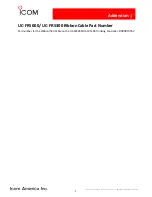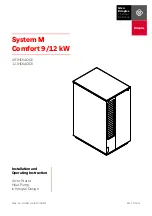
E-17
Operating Instructions and Owner’s Manual
Enerco | Heatstar ERSP Series Heater
Outside Combustion Air Supply
The Ener-Radiant SP heater is approved for installation with an
outside air supply system. Some compounds such as halogenated
hydrocarbons or other corrosive chemicals in the air can be drawn
into the equipment and cause an accelerated rate of corrosion
of some of the heater components. The use of such chemical
compounds near the enclosure should be avoided.
IMPORTANT: If the building has a slight negative pressure or
contaminants are present in the air, an outside combustion air
supply to the heaters is strongly recommended.
For an outside air supply, a four (4”) inch (10 cm) O.D. single
wall pipe may be attached to the heater. The duct may be up to
thirty (30’) ft (9.15 m). maximum length or two (2’) ft. minimum
(0.61m) length with no more than two (2) elbows. (See General
Requirements on page 14 for additional information.)
The air supply duct may have to be insulated to prevent
condensation on the outer surface. The outside air terminal should
be securely fastened to the outside wall by drilling four (4) 1/4”
(0.635 cm) diameter holes in the outside flange; wood screws or
bolts and expansion sleeves may be used to fasten terminal.
FIGURE 13: Non-Pressurized Outside Air Supply Duct
4" (10 cm)
Seal All Joints
Outside Air
Terminal
Flex Pipe
6" (15 cm) to
12" (30 cm) Long
4" (10 cm)
Seal All Joints
Flex Pipe
6" (15 cm) to
12" (30 cm) Long
Outside Air
Terminal
NOTE:
Flue pipe requires additional
support. Flex pipe will not
support riser and outside
air terminal
Vertical Outside Air
Horizontal Outside Air
PVC Pipe, “Dryer Hose”, or equivalent may be used instead of
standard vent pipe.
SECTION 6
Gas Piping
Read applicable warnings in (Section 1) before proceeding with
Gas Pipe installation. Improper installation may result in property
damage, severe injury, or death.
Meter and service must be large enough to handle all the burners
being installed plus any other connected load. The gas line which
feed the system must be large enough to supply the required gas
with a maximum pressure drop of 1/2” water column (0.12 kPa).
When gas piping is not included in the layout drawing, the local gas
supplier will usually help in planning the gas piping.
A 1/2” tapping at each burner location must be located and
oriented as shown in (Figure 14). To check system pressure, put a
plugged 1/8” NPT tapping in the gas line at the connection to the
burner farthest from the supply. Before connecting the burners to
the supply system, verify that all high pressure testing of the gas
piping has been completed. Do not high pressure test the gas piping
with the burners connected.
Follow these instructions to ensure a professional gas supply
installation:
•
Support all gas piping with suitable pipe hanging
materials.
•
Use wrought iron or wrought steel pipe and malleable
iron fitting. All pipe fittings should be new and free
from defects. Carefully ream the pipe and tubing ends
to remove obstructions and burrs.
•
Use L.P. gas-resistant joint compound on all pipe
threads.
•
Check the pipe and tubing ends for leaks before
placing heating equipment into service. When
checking for gas leaks, use soap and water solution:
NEVER USE AN OPEN FLAME.
Install the flex gas connector as shown. The flex gas connector
accommodates expansion of the heating system and allows for easy
installation and service of the burner.
FIGURE 14: Gas Line Connection with Stainless Steel Flex Gas
Connector
Shut-Off Valve must be parallel
to burner gas inlet. The 2” (5 cm)
displacement shown is for the cold
condition. This displacement may
reduce when the system is fired.
Shut – off Valve
12"
2"
1/2" Stainless Steel Flex Gas Connector
Stk. #16401
90°
45°
0°
45°
Heater Movement
Heater Movement
Heater Movement
Heater Movement
FIGURE 14A: Incorrect Gas Line Connection with Stainless
Steel Flex Gas Connector
















































